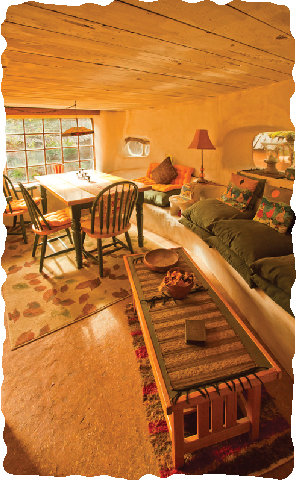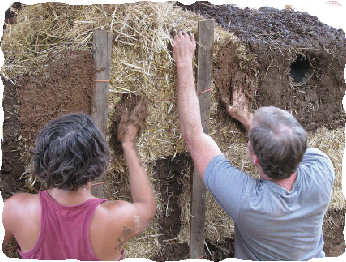

1. Health
Modern building materials can be potentially toxic to both builders and inhabitants. These materials can include neurotoxins, carcinogens, hormone mimics and reproductive disruptors, which could be playing a role in a number of today's increasing health problems. Even the mainstream press often carries stories of cancers and respiratory problems linked to formaldehyde-based glues, plastics, paints, asbestos, and fiberglass. The toxicity of these materials impacts everyone associated with them: workers in the factories, builders on the construction site, and the inhabitants of those homes.
In contrast to these toxic materials, what could be less toxic than the clay, sand, water, and straw used to make cob?

2. Financial
Empowerment
Most new houses cost at least $100,000 to build and take a lifetime to pay for. Real earnings are declining, and housing costs continue to rise, trapping people in lifelong mortgages. Many homeowners take jobs they do not like to pay for houses they do not love.
But it doesn’t have to be this way. By using local, unprocessed materials such as earth and straw, by building smaller and smarter, and by providing much of the labor yourself, you can create a home that is almost unbelievably affordable. With earthen buildings especially, the raw material is almost free, and the skills needed are very basic. Many people have built cob homes for under $5,000. You can also save yourself money in the long run with a smaller, more efficient house that uses simple passive solar technology for heating and cooling.
3. Durability
All biological materials have a predictably short life and degrade over time. Wooden structures generally survive for only a few generations. As we currently build, using fast-grown softwood, a house is in poor shape in a half a century. Earth by contrast, being geological lasts indefinitely. Inhabited earthen buildings in the Middle East and India are often more than a thousand years old! Earthen walls are also fireproof and immune to wood-eating insects like termites.
“
placeholder
4. Comfort
The breathable clay walls in cob houses seem to pull some of the moisture out of humid air keeping the inside cooler in hot humid weather. In winter cob absorbs the energy of the sun during the day and radiates it back into the building at night, keeping the inside warm and cozy.
